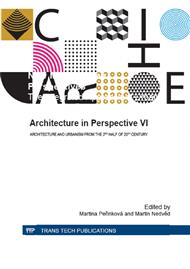p.132
p.137
p.141
p.147
p.153
p.158
p.164
p.171
p.176
40-Year Development of Ecologically Conscious Architecture in Slovakia
Abstract:
The year 1973 was a breakthrough year in the development of architecture. It triggered a crisis in society as well as the end of a period of relative prosperity and wasting of energy, which until then did not constitute a limiting factor. The crisis has forced to seek a new and more efficient architecture. The following decades were each in their own way characteristic particular in how architects approached to reduce the energy consumption of buildings and how they resolved the relationship of the building to the surrounding and the environment at all. My paper maps ecological ideas in architecture in Slovakia on the background of broader context. Initial decade was about searching and experiments. Mainly theoretical and research projects appeared. In the following period, first projects implementing ecological ides were built, e.g. experimental residential house in Holíč or solar house in Levice. Ecological aspects in architecture ascended to the real centre of interest in Slovakia from the 90s. After the change of political situation, sustainability was perceived more intense, as evidenced by a greater number of ecological houses of this period. Alternative building materials as well as the effort to reduce energy consumption were the driving force to the design of new buildings. New ideas often associated with an endeavor to define an appearance of ecological architecture are observable in many buildings, e.g. clay houses or solar collector house in Zvolen. My paper documents the development of sustainable architecture in Slovakia from the first attempts to the standardization of sustainable architecture with characteristic examples of ecologically conscious architecture of mentioned periods.
Info:
Periodical:
Pages:
164-170
Citation:
Online since:
November 2014
Authors:
Keywords:
Permissions:
Share:
Citation:


